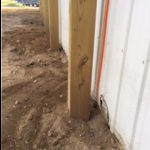DEAR POLE BARN GURU: Hello, I am from Webster SD and I built a pole barn and insulated it. I then put turf above gravel floor and use it for a indoor baseball practice facility. It can be heated as we have heaters in there. We have a huge problem and was wondering if you could help us solve it. I went in there today and the humidity was 85%. Under the turf is wet. What is causing this and how do we solve it? We have bats in there that are showing early signs of rust and it has been closed up for about a month. Thanks, CHAD in WEBSTER
 DEAR CHAD: The water is coming from the ground, and even makes its way up through concrete. You will need to remove the turf and then install a high quality sealed vapor barrier which is resistant to punctures or tears beneath it. In the research I have done, it appears the folks at Americover (www.americover.com) can probably make the best recommendations as to the product which will best fit your needs and budget.
DEAR CHAD: The water is coming from the ground, and even makes its way up through concrete. You will need to remove the turf and then install a high quality sealed vapor barrier which is resistant to punctures or tears beneath it. In the research I have done, it appears the folks at Americover (www.americover.com) can probably make the best recommendations as to the product which will best fit your needs and budget.
Depending upon how you have insulated the building, it may also be necessary to add ventilation in order to remove excess humidity from the air.
DEAR POLE BARN GURU: Can a pole barn be mounted to a house that has a cinder block foundation? RAY in BROCKPORT
 DEAR RAY: If the question is can a pole barn (post frame building) be mounted to a block foundation, as long as the foundation is adequate to carry the imposed loads, certainly. Brackets are made to either pour into a foundation, or be retrofitted to one.
DEAR RAY: If the question is can a pole barn (post frame building) be mounted to a block foundation, as long as the foundation is adequate to carry the imposed loads, certainly. Brackets are made to either pour into a foundation, or be retrofitted to one.
If you want to attach a post frame building to a house with a cinder block foundation, the post frame building would not structurally rely upon the block. Instead, it would typically be a free standing structure abutted to the existing building and foundation.
DEAR POLE BARN GURU: Is a 28×24 pole barn with 8 foot ceiling height large enough to start a grow room? ELIZABETH in DUNDEE
 DEAR ELIZABETH: It will depend upon how many plants you intend to grow. A mature plant requires four square feet of area and you need to have space to walk alongside. The eight foot high ceiling might be a bit tight as well, as some plants have the capability to grow to be as tall as a house. My best recommendation is to err on the side of caution and construct the largest footprint building which you can economically justify and which will fit within the available space.
DEAR ELIZABETH: It will depend upon how many plants you intend to grow. A mature plant requires four square feet of area and you need to have space to walk alongside. The eight foot high ceiling might be a bit tight as well, as some plants have the capability to grow to be as tall as a house. My best recommendation is to err on the side of caution and construct the largest footprint building which you can economically justify and which will fit within the available space.






